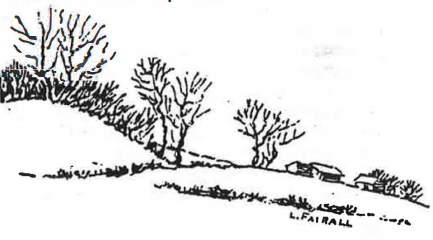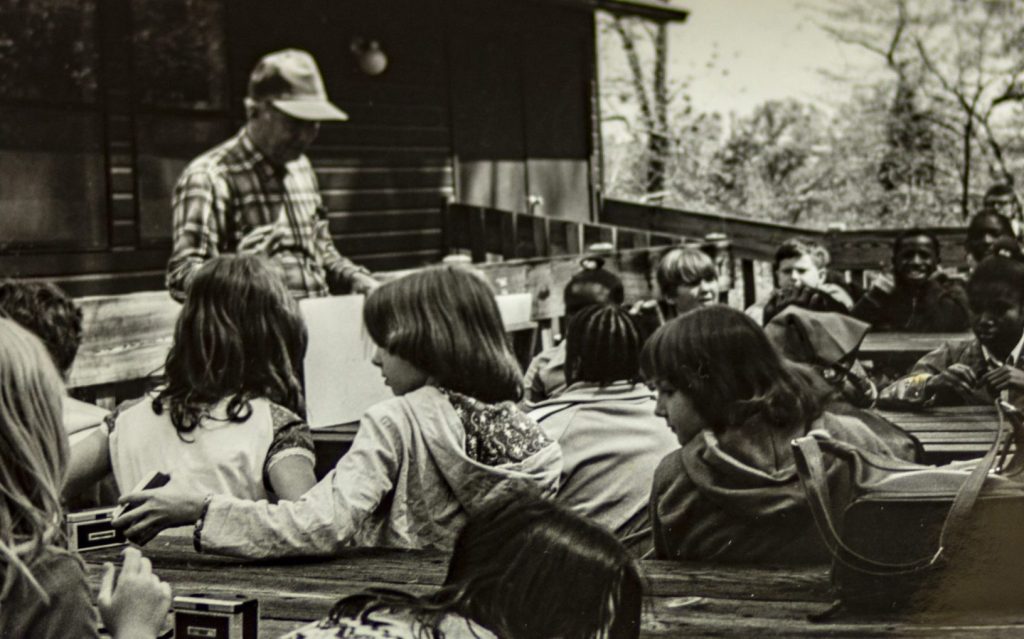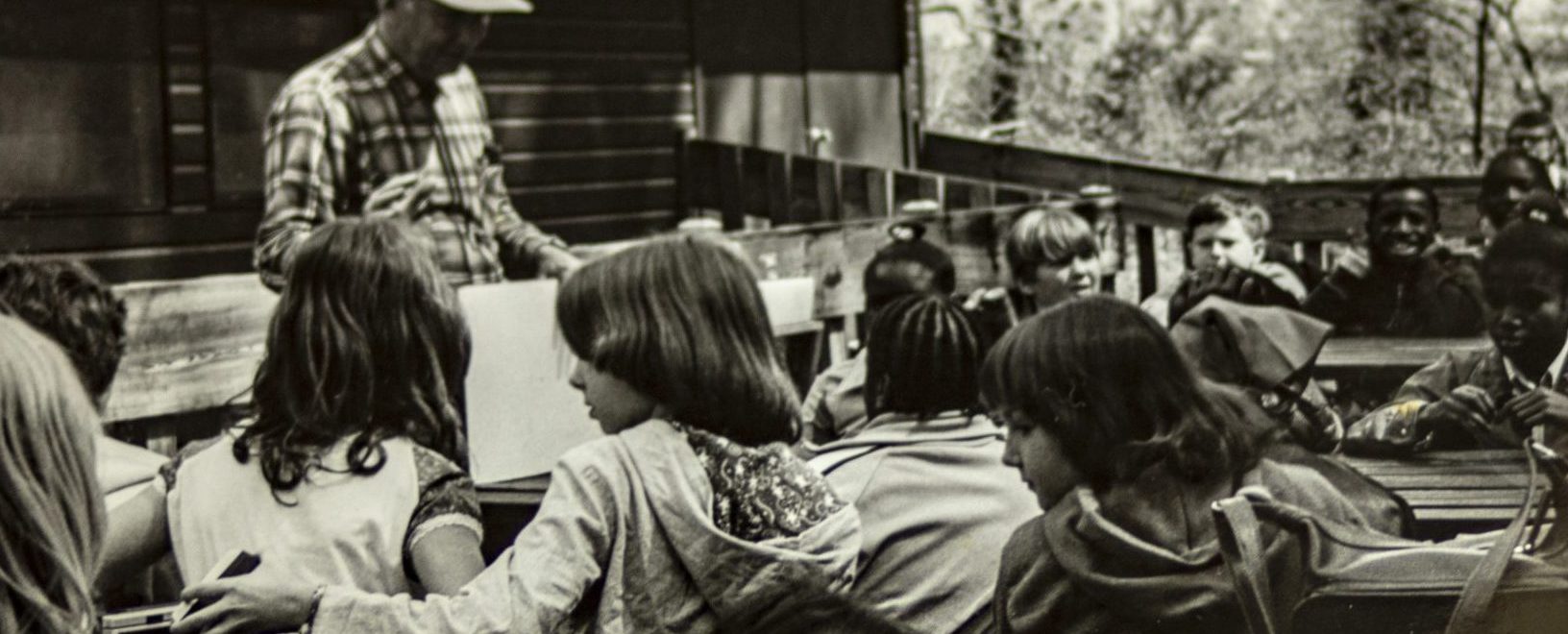On our 68th birthday, we’re looking back at our first 20 years as the Alice Ferguson Foundation. Some things have changed, but most remain the same as the once were. Enjoy!
Written by Pat Vanderslice
Any child or teacher coming to Hard Bargain today finds a smoothly running program that seems always to have been that way. And yet the truth is that the program is still young and evolving, and most of the people who first planned and developed it are still living nearby. In tracing back the many different strands that combined to form today’s environmental education program one comes inevitably to Henry and Alice Ferguson and the friends they attracted to this area after World War II. It was the period when Washington began to burst out of its urban base and consume the surrounding farmland for suburban development. The young families who built their homes near Hard Bargain were anxious to preserve the unspoiled acres of woods and fields in the area, and instill an appreciation of such surroundings in their children. It seems that environmentalists were incubating in Accokeek even before Rachel Carson’s Silent Sping was published in 1962.

Hard Bargain Farm
In the early Fifties after Alice’s death, Mr. Ferguson agreed to let his neighbors set up a nursery school in the unused farmer’s cottage on Bryan Point Road. By 1954 he had reached the decision to give the cottage and the bulk of his property, in stages, to the local community. Thus the Alice Ferguson Foundation, a tax exempt educational and charitable organization, was set up to receive and use this gift. With great energy and enthusiasm the early members of the Foundation plunged into plans for the future use of the land and facilities of Hard Bargain, in a manner consistent with “maintaining the open and wooded character of the riverfront property”. The seeds of today’s program had already been planted as early as 1956 when an expert from the University of Maryland was called in to advise on summer science programs. Later Belva Jensen organized a series of summertime nature classes for school children; these led eventually to a summer field biology course for high school students, in cooperation with the Prince George’s County school system.
At the same time, the Planning Committee of the Foundation under Dick Kenah was studying to make the best possible use of Mr. Ferguson’s bequest of the remainder of his farm in 1961. Dick cherished a dream of making Hard Bargain a demonstration farm of the 1920s era with horse-drawn plow for authenticity. Max North, an early leader of the Foundation, urged the Board to make the farm and surrounding natural environments available as “outdoor classrooms” — an idea strongly promoted by both the Depanment of Agriculture and the Prince George’s County Board of Education. After Max’suntimely death in 1964, the first nature trail was established in his name and built by Roy Jensen in the fields and woods across the road from the farm. Max North’s name is now known to thousands of school children who had their first taste of ecology studying the field, creek and woods encompassed by this trail. But this gets ahead of the story.
In 1962, Mr. Ferguson and the Foundation resolved to cooperate with the Federal Government in establishing Piscataway Park by donating eighty-five acres of bottom land — but with the important condition that farming and nature study plans not be disrupted. That same year the Foundation definitely set its sights on developing an educational program that would cover nature study, conservation and a demonstration farm. Innumerable hours were spent by Foundation members over the next several years meeting with government and education experts to draw up plans for such a program. E. Kenah fondly recalls being sent on an assignment with husband Dick, the Gasparovics and the Warehams to visit three widely scattered demonstration farms, a trip she views as “a pure pleasure package”. It is hard to believe there was a time when we didn’t know how to teach children on a farm. Bill Perry, an idea man from the National Park Service, was selected to draw up a report (still available in the office) analyzing the resources of Hard Bargain and the multiple ways they could be used as an outdoor laboratory.
The Max North Trail was no sooner completed with accompanying sign posts and self-guiding trail booklets than elementary schools began to use it in greater numbers than ever anticipated. With E. Kenah and Thelma Gasparovic doing the scheduling, groups came from as farm away as Silver Spring. Things appeared to go smoothly except for the horses that were boarded in the field. They caused serious erosion along the creek banks, making it necessary to fence off Accokeek Creek except for the two bridge crossings and the area where animals still drink and cross today. After several teachers wrote to the Foundation Board that the horses had frightened the children and sometimes snatched away their lunch bags, the animals were sent back to their owners. Local teenagers trained to guide groups on the trail after school and during summers were given a little black, white and green badge labeled “AFFfG” – Alice Ferguson Foundation Trail Guide. By 1966, due to the success of the Max North Trail, plans were underway to establish an alternate trail on land leased from the Accokeek Foundation. This would eventually be known as the Swamp Trail.

rolling hills by L. Fairall
When the last half of Mr. Ferguson’s land was given into the care of the Foundation in 1961, Paul Burton was hired to do “minimal maintenance” on the farm. Hank Xander joined him a year later, after his discharge from the Navy. The idea of a family-type demonstration farm where students could get hands-on experience by helping with the farm work had great appeal, but the realization of such a plan took several years. We had to learn bit by bit how to handle the groups, and what activities best complemented the stated purpose of learning about “Man and His Relationship to the Land”. Nancy Wagner’s kindergarten classes from the cottage were the first (albeit unofficial) groups to do “the farm tour”, an experience quite different from the tour we know today. At that time there were no sheep, goats, pigs or dairy cows; hay and tobacco were the main crops. By 1967 the combined attraction of the farm and the nature trail was bringing more than 3,000 children each year to Hard Bargain. Paul and Hank served as expert tour guides on the farm, while the groups guided themselves around the Max North Trail with the help of the Jensens’ explanatory booklet and numbered posts. Temporary toilet facilities were strategically placed so as to be convenient — but not visible -from Bryan Point Road. Our “day group” program was well on its way.
Concurrently, talks were undertaken with the Boards of Education of both Prince George’s and Charles Counties to plan a structured, cooperative program of outdoor education which ideally would include a two-day, overnight stay at the farm. It became very evident that the Outdoor Education Program needed both a director and a building of its own. The Building Committee under Bud Biles considered many options, the favorite being to have two very spare log cabins as bunkhouses and a larger building for rainy day activities and meals (which would be prepared at school kitchens).
With the approval of a pilot program in early ’69 the die was cast. Overnight accommodations for forty fifth graders had to be carved out of existing farm buildings, as the proposals of the Building Committee were years from fruition. The plan was to use the cottage as the dining hall, bathroom and girls’ dormitory. Hank remembers taking the tub out of the bathroom, replacing it with a sink and toilet and running a divider down the middle of the room so it could accommodate both boys and girls. Outside he constructed a washstand which the children filled by carrying water from the outdoor faucet. The boys’ sleeping accommodations were less genteel. Five double-decker bunks were set up between the stanchions in the dairy barn and another five were placed in the “night pasture” (today’s corn sheller room), after first pouring a cement floor. The cows reacted to their displacement with predictable annoyance. Finally, Hard Bargain was ready for the first overnight group. Those children arrived October 6, 1969.

There were only two groups that fall — Coila Ambrose’s fifth grade from Accokeek Elementary and Joe Marsden’s from Malcolm Middle School. The numbers rose quickly to seven in the spring of ’70, eleven in the fall and twenty by the spring of ’71. The scheduled activities were Woodland Survival, Max North Trail, Swamp Trail, Farm Tour, and Early American Tools which was taught at the Colonial Farm. Serving as guides were Paul Burton and Hank Xander, the classroom teachers, and the supervisors from the two counties. No parents were invited as overnight chaperones since the supervisors and teachers stayed all night. The meals, which Hank remembers as being excellent, were prepared by the able cooks at Accokeek Elementary. It was not only the children who benefited from all this activity; the farm was given a new sense of purpose by having the school groups there. This initial success of the pilot program led the Board to seek suitable (albeit temporary) quarters to house the children in winter so that the program could run all through the school year. The Moyaone Building by the pool and the pool bathrooms were pressed into service as a make-do substitute starting in the Fall of ’72. The first-ever wintertime classes proved the arrangement workable, if not entirely comfortable. There was a memorable thank you letter from one child whose only complaint was that her toothpaste froze.
At the same time the day groups continued to come Spring and Fall. To add hands-on activity to their visit a new trail was built called the “Discovery Trail”, later the “Kiddie Trail”, which is now all but obliterated. It zigzaged down the steep side of a ravine from the Ferguson driveway to the barnyard and was a magical place in the early Springtime when the wildflowers were in bloom. In 1971 thirty-four acres of wooded upland along Accokeek Creek were purchased and used for, among other things, the famous activity of getting lost in the woods. Not until ’73 was a well-worn path behind the Moyaone Building formalized as the Ecology Trail with the construction of two bridges which made it possible, for the first time, to walk all the way to the Potomac River.
Such endeavors don’t just run themselves. As early as 1968 the search was on for an Executive Director, and in 1970 Bernie Wareham assumed the post after retiring from the Federal government. In addition to juggling all the other activities of the Foundation, his job included development of the program, care of the trails and buildings and the all-important job of overseeing the planning and construction of a permanent year-round facility for the students.
The other pressing need was for additional staff to handle the growing number of classes. The National ParkService was persuaded to provide salaries for a few part-time guides and, in 1971 Coila Ambrose, Evelyn Biles, Joy Rabb and Peggy Schaumberg were hired as our first official staff. The program was given a more solid ecological bent with the introduction of the Plant and Animal and Soil & Water classes developed by the school systems in order to introduce the children to the ideas of conservation and pollution control. In addition, in the Summer of ’72 the guides were sent to Charles County Community College for a two-week field ecology course. In the ensuing years many more guides benefited from such courses which provided a real baptism of fire for some. It is a tribute to these early guides to note that in the Fall of ’73 a Park Service naturalist asked if we could help train the guides at Fort Washington because we did such a good job at Hard Bargain.
Read the rest of the story in Part 2!

